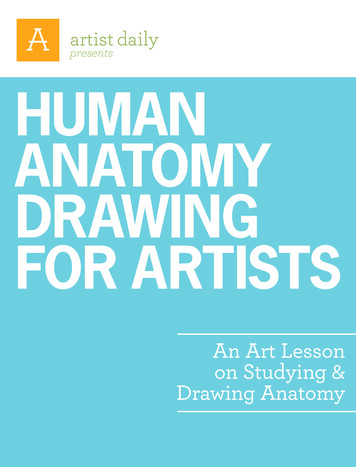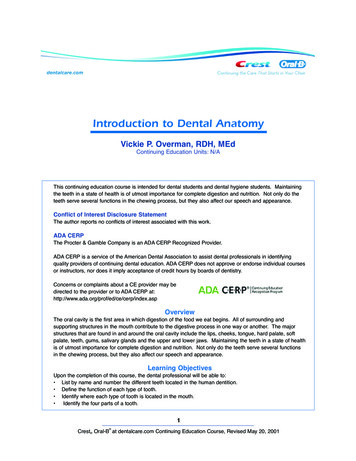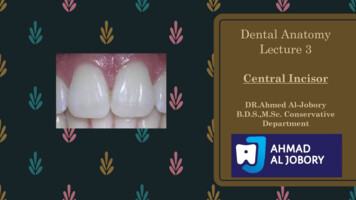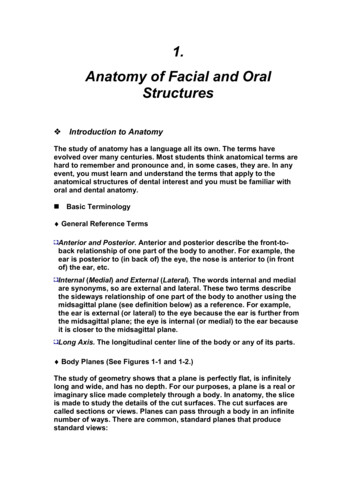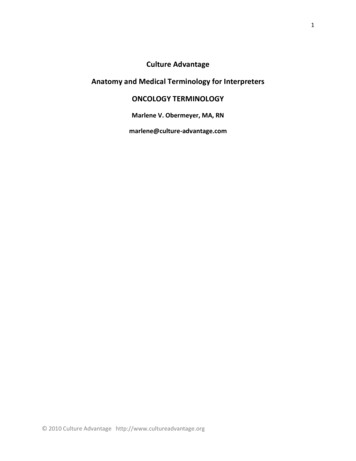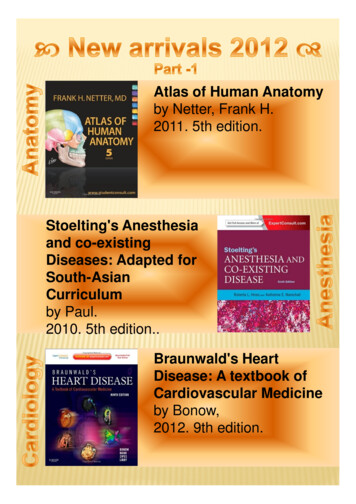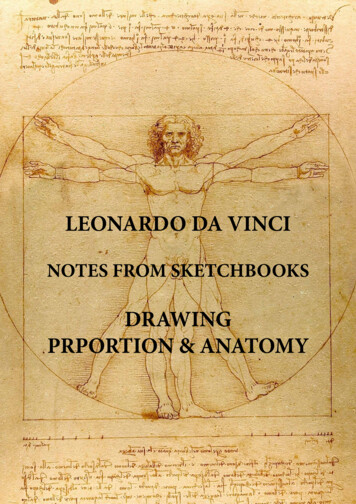
Transcription
LEONARDO DA VINCINOTES FROM SKETCHBOOKSDRAWINGPRPORTION & ANATOMY
LEONARDO DA VINCINOTES FROM SKETCHBOOKSDRAWINGPRPORTION & ANATOMYNotes and artworks by Leonardo Da VinciTranslated from original Italian by John Francis RigaudProduced by Vladimir LondonAnatomy Master Classhttp://AnatomyMasterClass.com
DRAWINGPROPORTION
Chap. I.—What the young Student in Painting ought inthe first Place to learn.The young student should, in the first place, acquire a knowledge of perspective, toenable him to give to every object its proper dimensions: after which, it is requisitethat he be under the care of an able master, to accustom him, by degrees, to a goodstyle of drawing the parts. Next, he must study Nature, in order to confirm and fix inhis mind the reason of those precepts which he has learnt. He must also bestow sometime in viewing the works of various old masters, to form his eye and judgment, inorder that he may be able to put in practice all that he has been taught.Chap. II.—Rule for a young Student in Painting.The organ of sight is one of the quickest, and takes in at a single glance an infinitevariety of forms; notwithstanding which, it cannot perfectly comprehend more thanone object at a time. For example, the reader, at one look over this page, immediatelyperceives it full of different characters; but he cannot at the same moment distinguisheach letter, much less can he comprehend their meaning. He must consider it word byword, and line by line, if he be desirous of forming a just notion of these characters.In like manner, if we wish to ascend to the top of an edifice, we must be content toadvance step by step, otherwise we shall never be able to attain it.A young man, who has a natural inclination to the study of this art, I would adviseto act thus: In order to acquire a true notion of the form of things, he must beginby studying the parts which compose them, and not pass to a second till he has wellstored his memory, and sufficiently practised the first; otherwise he loses his time, andwill most certainly protract his studies. And let him remember to acquire accuracybefore he attempts quickness.
Chap. III.—How to discover a young Man’s Disposition forPainting.Many are very desirous of learning to draw, and are very fond of it, who are,notwithstanding, void of a proper disposition for it. This may be known by theirwant of perseverance; like boys, who draw every thing in a hurry, never finishing, orshadowing.Chap. IV.—Of Painting, and its Divisions.Painting is divided into two principal parts. The first is the figure, that is, the lineswhich distinguish the forms of bodies, and their component parts. The second is thecolour contained within those limits.Chap. V.—Division of the Figure.The form of bodies is divided into two parts; that is, the proportion of the membersto each other, which must correspond with the whole; and the motion, expressive ofwhat passes in the mind of the living figure.Chap. VI.—Proportion of Members.The proportion of members is again divided into two parts, viz. equality, and motion.By equality is meant (besides the measure corresponding with the whole), that youdo not confound the members of a young subject with those of old age, nor plumpones with those that are lean; and that, moreover, you do not blend the robust andfirm muscles of man with feminine softness: that the attitudes and motions of oldage be not expressed with the quickness and alacrity of youth; nor those of a femalefigure like those of a vigorous young man. The motions and members of a strong manshould be such as to express his perfect state of health.
Chap. VII.—Of Dimensions in general.In general, the dimensions of the human body are to be considered in the length, andnot in the breadth; because in the wonderful works of Nature, which we endeavour toimitate, we cannot in any species find any one part in one model precisely similar tothe same part in another. Let us be attentive, therefore, to the variation of forms, andavoid all monstrosities of proportion; such as long legs united to short bodies, andnarrow chests with long arms. Observe also attentively the measure of joints, in whichNature is apt to vary considerably; and imitate her example by doing the same.Chap. VIII.—Motion, Changes, and Proportion ofMembers.The measures of the human body vary in each member, according as it is more or lessbent, or seen in different views, increasing on one side as much as they diminish onthe other.Chap. IX.—The Difference of Proportion between Childrenand grown Men.In men and children I find a great difference between the joints of the one andthe other in the length of the bones. A man has the length of two heads from theextremity of one shoulder to the other, the same from the shoulder to the elbow, andfrom the elbow to the fingers; but the child has only one, because Nature gives theproper size first to the seat of the intellect, and afterwards to the other parts.
Chap. X.—The Alterations in the Proportion of the humanBody from Infancy to full Age.A man, in his infancy, has the breadth of his shoulders equal to the length of the face,and to the length of the arm from the shoulder to the elbow, when the arm is bent. Itis the same again from the lower belly to the knee, and from the knee to the foot. But,when a man is arrived at the period of his full growth, every one of these dimensionsbecomes double in length, except the face, which, with the top of the head, undergoesbut very little alteration in length. A well-proportioned and full-grown man, therefore,is ten times the length of his face; the breadth of his shoulders will be two faces, andin like manner all the above lengths will be double. The rest will be explained in thegeneral measurement of the human body.Chap. XI.—Of the Proportion of Members.All the parts of any animal whatever must be correspondent with the whole. So that,if the body be short and thick, all the members belonging to it must be the same.One that is long and thin must have its parts of the same kind; and so of the middlesize. Something of the same may be observed in plants, when uninjured by men ortempests; for when thus injured they bud and grow again, making young shoots fromold plants, and by those means destroying their natural symmetry.Chap. XII.—That every Part be proportioned to its Whole.If a man be short and thick, be careful that all his members be of the same nature, viz.short arms and thick, large hands, short fingers, with broad joints; and so of the rest.Chap. XIII.—Of the Proportion of the Members.Measure upon yourself the proportion of the parts, and, if you find any of themdefective, note it down, and be very careful to avoid it in drawing your owncompositions. For this is reckoned a common fault in painters, to delight in theimitation of themselves.
Chap. XIV.—The Danger of forming an erroneousJudgment in regard to the Proportion and Beauty of theParts.If the painter has clumsy hands, he will be apt to introduce them into his works, andso of any other part of his person, which may not happen to be so beautiful as it oughtto be. He must, therefore, guard particularly against that self-love, or too good opinionof his own person, and study by every means to acquire the knowledge of what is mostbeautiful, and of his own defects, that he may adopt the one and avoid the other.Chap. XV.—Another Precept.The young painter must, in the first instance, accustom his hand to copying thedrawings of good masters; and when his hand is thus formed, and ready, he should,with the advice of his director, use himself also to draw from relievos; according to therules we shall point out in the treatise on drawing from relievos.Chap. XVI.—The Manner of drawing from Relievos, andrendering Paper fit for it.When you draw from relievos, tinge your paper of some darkish demi-tint. And afteryou have made your outline, put in the darkest shadows, and, last of all, the principallights, but sparingly, especially the smaller ones; because those are easily lost to the eyeat a very moderate distance.Chap. XVII.—Of drawing from Casts or Nature.In drawing from relievo, the draftsman must place himself in such a manner, as thatthe eye of the figure to be drawn be level with his own.
Chap. XVIII.—To draw Figures from Nature.Accustom yourself to hold a plummet in your hand, that you may judge of the bearingof the parts.Chap. XIX.—Of drawing from Nature.When you draw from Nature, you must be at the distance of three times the height ofthe object; and when you begin to draw, form in your own mind a certain principalline (suppose a perpendicular); observe well the bearing of the parts towards that line;whether they intersect, are parallel to it, or oblique.Chap. XX.—Of drawing Academy Figures.When you draw from a naked model, always sketch in the whole of the figure, suitingall the members well to each other; and though you finish only that part whichappears the best, have a regard to the rest, that, whenever you make use of suchstudies, all the parts may hang together.In composing your attitudes, take care not to turn the head on the same side as thebreast, nor let the arm go in a line with the leg. If the head turn towards the rightshoulder, the parts must be lower on the left side than on the other; but if the chestcome forward, and the head turn towards the left, the parts on the right side are to bethe highest.Chap. XXI.—Of studying in the Dark, on first waking inthe Morning, and before going to sleep.I have experienced no small benefit, when in the dark and in bed, by retracing in mymind the outlines of those forms which I had previously studied, particularly such ashad appeared the most difficult to comprehend and retain; by this method they will beconfirmed and treasured up in the memory.
Chap. XXII.—Observations on drawing Portraits.The cartilage, which raises the nose in the middle of the face, varies in eight differentways. It is equally straight, equally concave, or equally convex, which is the first sort.Or, secondly, unequally straight, concave, or convex. Or, thirdly, straight in the upperpart, and concave in the under. Or, fourthly, straight again in the upper part, andconvex in those below. Or, fifthly, it may be concave and straight beneath. Or, sixthly,concave above, and convex below. Or, seventhly, it may be convex in the upper part,and straight in the lower. And in the eighth and last place, convex above, and concavebeneath.The uniting of the nose with the brows is in two ways, either it is straight or concave.The forehead has three different forms. It is straight, concave, or round. The firstis divided into two parts, viz. it is either convex in the upper part, or in the lower,sometimes both; or else flat above and below.Chap. XXIII.—The Method of retaining in the Memory theLikeness of a Man, so as to draw his Profile, after havingseen him only once.You must observe and remember well the variations of the four principal features inthe profile; the nose, mouth, chin, and forehead. And first of the nose, of which thereare three different sorts, straight, concave, and convex. Of the straight there are butfour variations, short or long, high at the end, or low. Of the concave there are threesorts; some have the concavity above, some in the middle, and some at the end. Theconvex noses also vary three ways; some project in the upper part, some in the middle,and others at the bottom. Nature, which seems to delight in infinite variety, gives againthree changes to those noses which have a projection in the middle; for some have itstraight, some concave, and some convex.
Chap. XXIV.—How to remember the Form of a Face.If you wish to retain with facility the general look of a face, you must first learn howto draw well several faces, mouths, eyes, noses, chins, throats, necks, and shoulders; inshort, all those principal parts which distinguish one man from another. For instance,noses are often different sorts. Straight, bunched, concave, some raised above, somebelow the middle, aquiline, flat, round, and sharp. These affect the profile. In the frontview there are eleven different sorts. Even, thick in the middle, thin in the middle,thick at the tip, thin at the beginning, thin at the tip, and thick at the beginning.Broad, narrow, high, and low nostrils; some with a large opening, and some more shuttowards the tip.The same variety will be found in the other parts of the face, which must be drawnfrom Nature, and retained in the memory. Or else, when you mean to draw a likenessfrom memory, take with you a pocket-book, in which you have marked all thesevariations of features, and after having given a look at the face you mean to draw,retire a little aside, and note down in your book which of the features are similar to it;that you may put it all together at home.Chap. XXV.—That a Painter should take Pleasure in theOpinion of every body.A painter ought not certainly to refuse listening to the opinion of any one; for weknow that, although a man be not a painter, he may have just notions of the forms ofmen; whether a man has a hump on his back, a thick leg, or a large hand; whether hebe lame, or have any other defect. Now, if we know that men are able to judge of theworks of Nature, should we not think them more able to detect our errors?
DRAWINGANATOMY
Chap. XXVI.—What is principally to be observed inFigures.The principal and most important consideration required in drawing figures, is toset the head well upon the shoulders, the chest upon the hips, the hips and shouldersupon the feet.Chap. XXVII.—Mode of Studying.Study the science first, and then follow the practice which results from that science.Pursue method in your study, and do not quit one part till it be perfectly engraven inthe memory; and observe what difference there is between the members of animalsand their joints.Chap. XXVIII.—Of being universal.It is an easy matter for a man who is well versed in the principles of his art
In drawing from relievo, the draftsman must place himself in such a manner, as that the eye of the figure to be drawn be level with his own. Chap. XVIII.—To draw Figures from Nature. Accustom yourself to hold a plummet in your hand, that you may judge of the bearing of the parts. Chap. XIX.—Of drawing from Nature. When you draw from Nature, you must be at the distance of three times the .
